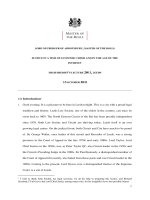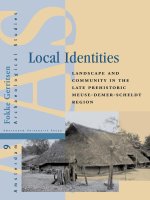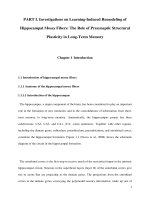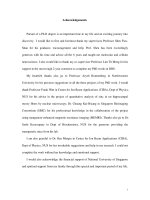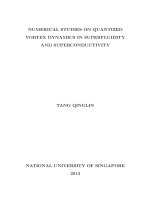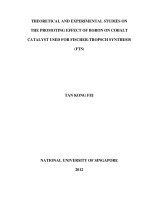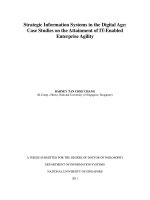Studies on the antibody repertoire in a dengue virus immune subject and isolation of neutralizing antibodies by phage display technology
Bạn đang xem bản rút gọn của tài liệu. Xem và tải ngay bản đầy đủ của tài liệu tại đây (4.32 MB, 122 trang )
STUDIES ON THE ANTIBODY REPERTOIRE IN A DENGUE VIRUS
IMMUNE SUBJECT AND ISOLATION OF NEUTRALIZING ANTIBODIES
BY PHAGE DISPLAY TECHNOLOGY
PATRICIA SUSANTO
(BBiomedSc., BSc.(Hons), The University of Melbourne)
A THESIS SUBMITTED FOR THE DEGREE OF MASTER OF SCIENCE IN
INFECTIOUS DISEASES, VACCINOLOGY AND DRUG DISCOVERY
DEPARTMENT OF MICROBIOLOGY
NATIONAL UNIVERSITY OF SINGAPORE
&
BIOZENTRUM
UNIVERSITY OF BASEL
2011
ACKNOWLEDGMENTS
This Master thesis would not have been possible without the support of various
people to whom I would like to express my sincere gratitude.
My deepest gratitude goes to my supervisors, A/Prof. Subhash Vasudevan and
A/Prof. Annelies Wilder-Smith for their valuable scientific guidance, insightful
advice, patience and support throughout this project.
I am immensely thankful to my supervisor, Dr. Nicole Moreland, whose constant
help, support and encouragement in countless ways have made this thesis possible.
I also wish to express my heartfelt thanks to Prof. Duane J Gubler for all his insightful
guidance and assistance, and for giving me the opportunity to pursue my project in the
Emerging Infectious Diseases (EID) Signature Research Program, Duke-NUS
Graduate Medical School.
I wish to express my deepest appreciation to all the members of Vasudevan Lab for
their guidance, assistance and help. In particular, I would like to thank Elfin Lim, Dr.
Ravikumar Rajamanonmani, Dr. Danny Doan, and Dr. Prasad Paradkar, for giving me
valuable guidance and helpful scientific advices throughout the year. Special thanks to
Dr. Brett Ellis and Miss Amy Beth-Henry for their assistance in the mosquito work,
and to Miss Angelia Chow, Tan Hwee Cheng, Lin Xiuhua, Gayathri Manokaran and
Dr. Azlinda Anwar for their tremendous help in various areas of my project. Warm
2
and sincere thanks to Miss Lindy Wong for her endeavour in ensuring a smooth lab
operation. Thanks everyone for making the lab an enjoyable place to work in, and for
making this year an invaluable learning experience for me.
I would also like to thank National University of Singapore, Novartis Institute for
Tropical Diseases, Swiss Tropical Institute and University of Basel for making this
Joint MSc. program possible. In particular I thank Prof. Markus Wenk and Prof.
Vincent Chow.
My acknowledgment to Prof. Gerd Pluschke for his willingness to be the cosupervisor of my thesis.
In addition my thanks goes to all the lecturers from the various institutes involved in
this program for the valuable knowledge, perspectives and assistance.
I am deeply indebted to my family for being a constant source of strength and courage
and for always believing in me. Many thanks to Miss Casey Sautter for all those trips
for the much-needed cakes and coffee, to Miss Bianca Victorio for all her jokes that
never fail to cheer me up (and for the constant supply of chocolate, cookies and chips
at home), and to all my friends who have provided me with so much encouragement,
inspiration and emotional support throughout this year.
Singapore, December 2010
Patricia Susanto
3
TABLE OF CONTENTS
Acknowledgments…………………………………………………………………....2
Table of Contents…………………………………………………………………….5
Summary……………..…………………………………………………………….....9
List of Tables………………………………………………………………………...10
List of Figures…………………………………………………………………….…11
List of Abbreviations………………………………………………………………..13
1. Introduction
1.1
Background on Dengue Virus
1.1.1 Epidemiology, diagnosis and pathogenesis………………………….16
1.1.2 Antibody-Dependent Enhancement (ADE) …………………………18
1.1.3 Structural perspective, replication and life cycle…………………….19
1.2
Envelope (E) Protein as target of Flavivirus neutralizing antibody
1.2.1
Overview of the DENV Envelope (E) Protein…………………….…21
1.2.2
Roles of EDIII- reactive antibodies in virus neutralization………….23
1.2.3
Contribution of EDIII-specific antibodies to virus
neutralization in human sera………………………………………....25
1.3
Phage Display Technology…………………………………………………26
1.4
Aims of Study………...……………………………………………………..28
4
2. Materials and Methods
2.1
Preparation of antigens
2.1.1 Ectodomain III purified protein from DENV-2 and DENV-3
(i) Protein expression………………………………………...………31
(ii) Refolding by dialysis………………………………………..……31
(iii) Gel filtration…………………………………………………..…32
2.1.2 Whole virus antigen
(i) Live virus propagation in mosquito cell line (C6/36) ……………32
(ii) Preparation of UV-inactivated DENV-2 TSV01 and DENV-3
H87 whole virus antigens for ELISA.
a. Concentration and Purification by Sucrose Gradient……..…33
b. Western Blot…………………………………………………33
c. Buffer Exchange and UV Inactivation………………………34
2.2
Plaque Assay
2.2.1 Maintenance of BHK-21 cells……………………………………..…34
2.2.2 Plaque assay: Virus dilution, Adsorption, Incubation, Fixation,
Staining………………………………………………………….……35
2.3
Plaque Reduction & Neutralization Test (PRNT) …………………..……35
2.4
Enzyme-Linked Immunosorbent Assay (ELISA) …………………..……35
2.5
Convalescent serum processing………………………………………....…36
2.6
Serum depletion………………………………………………………….…37
2.7
Phage library
2.7.1 Biopanning of Fab Phage-Display Library…………………..………38
2.7.2 Negative selection to eliminate His tag- and Rabbit Polyclonal
Antibody-binders from the library………………...…………………39
5
2.7.3 Polyclonal ELISA of Fab-Phage clone………………………………39
2.7.4 Small-Scale Phage Rescue……………………………………...……40
2.7.5 Monoclonal ELISA……………………………………………..……41
2.7.6 Western Blot to detect binding of phage to DENV-2 TSV01
whole virus and EDIII protein………………………………..………42
2.8
Determination of replication, dissemination and viremia titres of
DENV-2 EDEN and PDK-53 strains in mosquitoes at various time-points
post-inoculation
2.8.1 Intrathoracic inoculation…………………………………………..…42
2.8.2 Comparison of viremia titres of mosquitoes at various time points
post-infection between DENV-2 EDEN and DENV-2 PDK-53…..…43
3. Results and Discussion
3.1
Subject A- IRB Application for Human Serum Study…………………...46
3.2
Characterization of Serum from Subject A
3.2.1 Expression and Purification of DENV-2 and -3 Ectodomain III
(EDIII) …………………………………………………………….…48
3.2.2 Propagation of DENV-2 TSV01, DENV-3 H87, DENV-1, 2, 3
and 4 EDEN in C6/36 cell line……………………………………….50
3.2.3 Concentration, Sucrose gradient and UV-inactivation of
DENV-2 TSV01 and DENV-3 H87………………………………….51
3.2.4 ELISA Optimization for Serum Characterization……………………53
3.2.5 ELISA Using Serum from Subject A Against DENV-2 and
DENV-3……………………………………………………...………56
3.2.6 Plaque Reduction Neutralization Test (PRNT) …………………...…57
6
3.2.7 Optimization of the serum depletion using Qiagen Ni-NTA
Magnetic Agarose Beads…………………………………………..…60
3.2.8 EDIII depletion and PRNT……………………………………...……64
3.3
Subject A Infection Study
3.3.1 Optimization for mosquito infection…………………………………65
3.4
Phage Display Immune Library
3.4.1 The Chimeric Mouse/ Human EDIII Phage Library…………………67
3.4.2 Optimization of Biopanning using whole virus……………………...69
3.4.3 The Three Strategies Employed in Biopanning………………….…..71
3.4.4 Biopanning: STRATEGY I…………………………………………..71
3.4.5 Biopanning: STRATEGY II………………………………………….73
3.4.6. Biopanning: STRATEGY III- Identification of WV binders
and a WV/EDIII binder………………………………………………75
3.5
Discussion
3.5.1 Serum Characterization………………………………………………79
3.5.2 Phage Display Immune Library……………………………………...82
3.5.3 Conclusion……………………………………………………………84
4. Bibliography………………………………………………………………...…85
5. Appendices
Appendix 1. Pet16bD2T_T7 Promoter Sequence……………………………...……90
Appendix 2. Approved Institutional Review Board (IRB) Application
A. Application Form…………………………………………………...……92
B. Case Report Form…………………………………………………….…110
7
C. Patient Information Sheet and Consent Form………………………..…113
Appendix 3. Sequence alignment results between the E protein Ectodomain III
of DENV-2 PDK 53 and TSV01………………………………...…………121
8
SUMMARY
Dengue Virus (DENV) is known as the causative agent of Dengue Fever and Dengue
Hemorrhagic Fever / Dengue Shock Syndrome (DHF/ DSS). Infection with one of the
serotypes elicits long-term, homotypic protection but does not protect from the risk of
development of DHF/DSS upon subsequent infection with other serotype(s) via a
mechanism known as Antibody-Dependent Enhancement (ADE) by cross-reactive,
non-neutralizing antibodies. Previous studies using mouse mAbs demonstrated that
the Ectodomain III (EDIII) in the E protein of DENV is the primary target of the most
potent neutralizing antibodies against DENV. Interestingly, the EDIII-specific
antibodies are much less abundant than the EDI/II-specific antibodies, although they
may contribute more significantly to viral neutralization and protection. This study
aims to characterize the binding specificity of human convalescent serum from a
DENV-2-immune subject, and the potential change in its neutralizing capacity after
antibody depletion, to elucidate the role of EDIII in DENV neutralization. In addition,
Phage Display Technology was utilized to generate a DENV-immune Fab phage
library for investigation of antibody repertoire upon infection, and for identification of
EDIII-specific Fabs that are highly neutralizing.
9
LIST OF TABLES
Table 1.
Titres of DENV propagated in C3/36 cell line, determined by
51
Plaque Assay
Table 2.
The titre of DENV whole virus and EDIII-reactive antibody in
57
Subject A’s serum
Table 3.
DENV neutralization by Subject A’s serum
58
Table 4.
Summary of the input and output phage in Strategy I
72
Biopanning
Table 5.
Sequence analysis and variable gene usage of anti-DENV-2
79
EDIII Fab
10
LIST OF FIGURES
Figure 1.
Flavivirus life cycle
21
Figure 2.
Ribbon diagram of a DENV E Protein dimer
22
Figure 3.
EDIII lateral ridge antibody epitope
24
Figure 4.
Schematic overview of Biopanning in Phage Display
27
Technology
Figure 5.
Flavivirus infection history of Subject A
47
Figure 6.
Eluted fractions of soluble His-tagged DENV-2 EDIII
49
protein captured with Ni-NTA column
Figure 7.
Eluted DENV-2 EDIII protein fractions after refolding by
50
dialysis and purification by SEC
Figure 8.
DENV-2 TSV01 purification by Sucrose Gradient
52
Figure 9.
Western Blot with 9F12 MAb to identify sucrose gradient
53
fractions containing purified DENV-2 TSV01 virus particles
Figure 10.
Binding of 3H5 monoclonal antibody to DENV-2 TSV01
55
whole virus and EDIII
Figure 11.
Binding of D11c monoclonal antibody to DENV-3 H87
55
whole virus and EDIII
11
Figure 12.
Binding of Subject A’s serum to DENV-2 and DENV-3
56
whole virus and EDIII
Figure 13.
Determination of 50% DENV neutralization titre of Subject
58
A’s serum against the four DENV serotypes by PRNT
Figure 14.
Optimization of blocking conditions for serum depletion
60
Figure 15.
Optimization for serum depletion
61
Figure 16.
Depletion of EDIII-reactive antibody from Subject A’s
63
serum: SDS-PAGE and ELISA
Figure 17.
Depletion of EDIII-reactive antibody from Subject A’s
64
serum: PRNT
Figure 18.
Infection of BHK-21 cell line using the homogenate of
65
infected Ae.aegypti, detected by Immunofluorescence
Figure 19.
Generation of hybridoma and construction of the chimeric
68
human/mouse EDIII phage library
Figure 20.
Binding of 3H5 MAb to the captured DENV-2 TSV01
70
whole virus by Rabbit PAb
Figure 21.
Polyclonal ELISA (Strategy I)
73
Figure 22.
Polyclonal ELISA (Strategies II and III)
74
Figure 23.
Monoclonal ELISA (Biopanning Strategy III)
76
Figure 24.
Western Blot to show the binding of isolated Fab phage
78
clones H6, D10 and C9 to DENV-2 whole virus and EDIII
12
LIST OF ABBREVIATIONS
ADE
Antibody-Dependent Enhancement
β-ME
Beta-Mercaptoethanol
BSA
Bovine Serum Albumin
CDR
Complimentarity Determining Region
CMC
Carboxymethylcellulose
CPE
Cytopathic Effect
DENV
Dengue Virus
DHF
Dengue Haemorrhagic Fever
DSS
Dengue Shock Syndrome
E
Dengue Virus Envelope Protein
ED
Ectodomain
EDEN
Early Dengue Infection and Outcome Study
EDTA
Ethylenediaminetetraacetic acid
ELISA
Enzyme-linked Immunosorbent Assay
Fab
Antigen-binding Antibody Fragment
FBS
Fetal Bovine Serum
FITC
Fluorescein Isothiocyanate
g
Centrifugal force relative to gravity
His
Histidine
HRP
Horseradish Peroxidase
kb
kilobase
kDa
kiloDalton
IPTG
Isopropyl β-D-1-thiogalactopyranoside
IRB
Institutional Review Board
LB
Luria-Bertani
MAb
Monoclonal Antibody
MBP
Maltose Binding Protein
min
Minute
MOI
Multiplicity of Infection
NS
Non-Structural protein of Dengue virus
13
OD
Optical Density
PAb
Polyclonal Antibody
PBS
Phosphate Buffer Saline
PCR
Polymerase Chain Reaction
PEG
Polyethylene glycol
PFU
Plaque Forming Unit
PRNT
Plaque Reduction Neutralization Test
RNA
Ribonucleic Acid
rpm
Revolutions per minute
RT
Room temperature
SDS-PAGE
Sodium Dodecyl Sulfate Polyacrylamide Gel Electrophoresis
SEC
Size Exclusion Chromatography
TMB
3,3,5,5-tetramethylbenzidine
TY
Tryptone/Yeast
UV
Ultraviolet
WHO
World Health Organization
WV
Whole Virus antigen
14
Introduction
15
1.1. BACKGROUND ON DENGUE VIRUS
1.1.1 Epidemiology, diagnosis and pathogenesis
Dengue Virus infection is a leading emerging arboviral disease that is a major global
health problem, with highest incidence in the tropical and subtropical countries.
According to WHO in 2009, there were an estimated 2.5 billion people at risk of
infection, mainly in Southeast and South Asian, Caribbean, as well as Central and
South American regions. Almost 100 million cases of dengue infection are reported
each year, with an estimated 500000 cases manifesting into severe, life-threatening
dengue diseases, including Dengue Haemorrhagic Fever (DHF) and Dengue Shock
Syndrome (DSS) (2, 3). The rapid increase in the emergence of the disease is likely
the result of increase in human population, rapid urbanization, continued challenges in
the implementation of effective vector controls, and international air and sea travel.
Dengue viruses are transmitted to human beings through the bite of infected
mosquitoes of the Aedes genus (Ae. aegypti and Ae. albopictus). Transmission by Ae.
aegypti tends to be associated with sharp epidemics in contrast to the less efficient
transmission by Ae. albopictus that results in a slow-moving outbreak (4).
Ae aegypti has been highly adapted to urban environments, and the uncontrolled
urbanization occurring in many developing parts of the world enhances the expansion
of the mosquito population, making vector control more challenging. The prevalent
peridomestic water containers, discarded plastics, and unused tyres in such setting,
especially at building projects, are likely to be exploited by mosquitoes for the habitat
16
for its larvae. This results in more widespread breeding sites (not just domestic sites
or houses as previously known). This corresponds to the age profile shift of dengue in
Asia and in Latin America lately as adults (working population) are increasingly
affected, whereas in the past, children tend to bear the major burden of the disease (58).
The clinical features of dengue virus infection can range from an asymptomatic
infection to a self-limiting dengue fever, to severe cases of DHF/DSS, which has a
higher risk of occurring in secondary infection with a different DENV serotype. The
severe manifestations are characterized by high fever, bleeding, increased vascular
permeability/ rapid onset of capillary leakage, liver enlargement/ damage (indicated
by elevation in the levels of liver enzymes aspartate aminotransferase and alanine
aminotransferase), circulatory failure, accompanied by thrombocytopenia and
haemoconcentration. Complications such as gastrointestinal bleeding can also occur
in some cases (9, 10).
The intrinsic virulence of the dengue virus strains, the host innate response to viral
infections as well as other host factors such as genetic factors, nutritional status,
ethnicity, and underlying chronic disease could also be additional factors that
determine the severity of the pathogenesis of dengue virus infection (reviewed in
(11)).
Neutralizing antibody responses that develop after a dengue infection with a serotype
is believed to provide lifelong protection against re-infection with the same serotype.
In addition to the humoral/ antibody response, dengue-specific cellular immunity also
17
confers a long-term protection, although the roles and the mechanisms are less clearly
defined. DENV-specific T lymphocytes may have a role in viral clearance by the
killing of virus-infected cells and secreting the pro-inflammatory cytokines to limit
the infection. The roles of cellular immunity and humoral immunity must be equally
taken into consideration in designing any model of protection (e.g. vaccine) against
DENV. However, this study is focused on the humoral aspect of immunity following
DENV infection, more specifically the role and the identification of highly
neutralizing antibodies in DENV convalescent human serum.
1.1.2 Antibody-Dependent Enhancement (ADE)
DENV has four antigenically similar but immunologically distinct serotypes, namely
DENV1, 2, 3, and 4. Infection with one serotype can elicit the production of
antibodies that are cross-reactive with all four serotypes in a short term but will only
provide long-term protection against the serotype that caused the initial infection, i.e.
homotypic protection (11-13).
During subsequent infection with a different serotype of DENV, an individual may be
at a greater risk of developing more severe form of the disease, Dengue Hemorrhagic
Fever/ Dengue Shock Syndrome (DHF/DSS). Through a mechanism known as
Antibody Dependent Enhancement (ADE), these cross-reactive, non-neutralizing
antibodies bind to the virus and form immune complexes that are taken into target
cells that bear the Fcϒ-receptor such as monocytes/ macrophages, and thereby
increase the productive infection (11, 14, 15).
18
The requirement for binding of the Fc portion of antibody to induce ADE was
demonstrated by Balsitis et al, whereby the use of Fab and non- Fcϒ-receptor binding
variant (N297Q) resulted in the neutralization of infection instead of ADE (16).
Furthermore, subprotective levels of antibody have been shown to enhance the
severity of dengue infection in mice model. For neutralization to occur, the affinity of
the antibody to the epitopes on the surface of the virus and its concentration need to
be sufficiently high. This was demonstrated by the increased survival time as a result
of neutralization by MAb 4G2 at high doses, but significantly enhanced the infection
and reduced the mean survival time when it was administered at low doses (17).
1.1.3 Structural perspective, replication and life cycle
Dengue Virus (DENV) is a member of Flaviviridae family, and is categorized under
the flavivirus genus (18). The genome of DENV consists of a single positive-sense
RNA strand packaged by virus capsid protein in a host-derived lipid bilayer (18, 19).
The 11 kb genome has an open reading frame, translated as a polyprotein, which is
subsequently cleaved by cellular signal peptidase and viral proteases to yield three
structural proteins (C, prM and E) and seven non-structural proteins (NS1, NS2A/B,
NS3, NS4A/B, and NS5) (18). The structural proteins constitute the virus particle, and
the non-structural proteins are required for viral genome replication.
Attachment of DENV to host cell is mediated by several known surface receptors,
such as DC-SIGN (Dendritic-cell-specific ICAM-grabbing non-integrin, which is a
19
mannose-specific lectin that interacts with the carbohydrate residues on the DENV E
Protein), GRP78/BiP (glucose-regulating protein 78) and CD14-associated molecules
(20-23). Following attachment and entry into the host cell via receptor-mediated
endocytosis, acidification of the endosomal vesicle triggers the conformational
changes in the E protein, resulting in the fusion of the viral and host cell membranes
(Figure 1).
After fusion, the virus undergoes disassembly to release the positive-sense, singlestranded RNA genome into the host cytoplasm. This RNA is translated immediately
into a single polyprotein, that is subsequently processed by viral and host proteases.
The positive-sense genome is copied to make negative-sense RNA, which is
replicated by viral RNA polymerase to synthesize more viral genomes to be packaged
in the newly generated virions and more mRNAs for translation into viral proteins
(18).
The genome replication occurs on intracellular membranes, followed by the assembly
of the virus particles on the Endoplasmic Reticulum (ER) surface. This assembly of
structural proteins and newly synthesized single stranded RNA genome buds into the
lumen of the ER, forming a non-infectious, immature viral particle. The trans-Golgi
network transports it to the plasma membrane of the host cell where it is undergoes
cleavage by the host protease furin, to form a mature and infectious virion, which is
subsequently released from the host cell by exocytosis (18, 19).
20
Figure 1. Flavivirus life cycle (adapted from Mukhopadhyay 2005). Upon
attachment and entry into host cell via RME, conformational changes of the viral
E Protein drives fusion and disassembly of virus. Genome is released into host
cytoplasm, replicated or translated into polyprotein. Virus assembly occurs on ER
membrane, and immature virions are transported to the host plasma membrane via
the Golgi network. Virion matures upon cleavage by furin and released from the
host cell by exocytosis.
1.2 ENVELOPE
(E)
PROTEIN
AS
TARGET
OF
FLAVIVIRUS
NEUTRALIZING ANTIBODY
1.2.1 Overview of the DENV Envelope (E) Protein
The Envelope (E) protein is a component of the structural proteins of Dengue Virus,
together with the Capsid (C) and the pre-membrane/ membrane (prM/M) proteins. It
contains a cellular receptor binding site and a fusion peptide, and undergoes pHdependent oligomeric arrangement during fusion. This has been shown in the
21
formation of dimers at neutral pH and irreversible trimerization upon exposure to
acidic environment of endosome, resulting in the fusion of viral and cell membranes
(24, 25). The E protein has been shown to be the primary target for neutralizing
antibodies although antibodies specific for prM and NS proteins have also been
observed in previous studies (26-28).
The E protein is approximately 500 amino acids in length, which includes the Nterminal 400 amino acids that form the ectodomain. The crystal structures of the E
ectodomain of flaviviruses have shown that each E protein monomer consists of three
β-barrel domains in each. The figure below depicts the dengue virus E protein dimer
and the 3 domains of each monomer, EDI, II, and III shown as yellow, red and blue
respectively (Figure 2). Domain I (EDI, red) is a centrally located β-barrel structure
that connects Domain II and Domain III via flexible hinges which drive
conformational changes for fusion to occur. Domain II (EDII, yellow) contains the
highly conserved hydrophobic fusion loop at its distal end (19, 24).
(Pierson and Diamond 2009)
Figure 2. Ribbon diagram of a DENV E protein dimer with Ectodomains (ED)
I, II and III shown as red, yellow and blue ribbons, respectively. The fusion loop
at the tip of EDII is shown in green.
22
Domain III (EDIII, blue), is an Ig-like domain that is thought to contain the putative
receptor-binding sites and its pH-mediated conformational changes drives the fusion
between the viral and host cell membrane (26, 29). A crucial role for EDIII in virus
attachment is supported by the following observations: distal projection of EDIII from
the virion surface, numbers of mutations that impact virulence or tropism map to
EDIII, and the effective blocking of DENV2 entry into C6/36 by recombinant WNVEDIII (30). Furthermore, the mouse mAb 3H5 (with specificity for EDIII) has been
shown to block binding of DENV2 to the virus receptors at the attachment stage (31).
1.2.2 Roles of EDIII- reactive antibodies in virus neutralization
Much of the research to elucidate the role of EDIII-reactive antibodies in virus
neutralization has been performed with EDIII-specific mouse monoclonal antibodies
(MAbs) (27, 32, 33) (34-36). In general, the strongly neutralizing mouse MAbs are
serotype-specific and bind to epitopes on EDIII that are unique to each serotype.
Among a panel of well-characterized E-glycoprotein-specific MAbs, the EDIIIspecific MAbs were shown to block the DENV2 adsoprtion to Vero cells most
strongly (37, 38). Among the panel of well-characterized EDIII-specific murine
antibodies in the literature is 9F12, a hybridoma-derived MAb developed in the
Vasudevan Laboratory.The in vitro neutralization of all four DENV serotypes and
WNV by 9F12 in plaque reduction assays has been reported recently and further
suggests the important role of EDIII-specific antibodies in dengue virus neutralization
(39).
23
The four loops on the upper lateral surface of EDIII have been identified as the likely
target of many potent neutralizing antibodies. A study by Sukupolvi et al. identified
the contact residues of several DENV2 EDIII-specific MAbs with distinct neutralizing
potentials, and showed that the ones with strongest neutralizing activity and less
cross-reactivity bind to the epitopes on the lateral ridge of EDIII, centered at the
unique FG loop (Figure 3) (36).
(Sukupolvi-Petty et al 2007)
Figure 3. EDIII lateral ridge antibody epitope. Structure of DENV-2 EDIII,
with the corresponding 16 amino acids of the WNV E16 neutralizing antibody
epitope highlighted, including the unique FG loop.
Although extensive epitope mapping studies have been performed with mouse MAbs
against DENV, much less has been done with human MAbs to study the interactions
between DENV and antibody at the molecular level. Nevertheless, the many
observations on neutralization by antibodies that bind EDIII epitopes in mouse
models make the potential neutralizing mechanism by the EDIII-specific antibodies
very attractive to investigate, especially in the DENV human infections.
24
1.2.3 Contribution of EDIII-specific antibodies to virus neutralization in
human sera
A recent investigation by Wahala et al. was focused on the level and specificity of
EDIII-reactive antibodies in the convalescent sera of people who have recovered from
primary and secondary DENV infections, as well as their contribution to DENV
neutralization (40). They reported the presence of EDIII-reactive antibodies in both
the primary and secondary DENV-immune human sera. Whereas the EDIII-reactive
antibodies in the primary immune sera were serotype-specific, the antibodies in the
secondary immune sera were directed against a cross-reactive epitope on EDIII. This
was deduced from the observation that most of EDIII reactivity to the second serotype
was lost when the secondary immune sera were depleted using one serotype’s MBPEDIII (40).
The levels of EDIII- reactive antibodies in the convalescent sera samples were low in
the Wahala et al study (40), leading to the hypothesis that these antibodies only play a
minor role in neutralization. Strikingly, the change in neutralization titres in EDIIIdepleted sera compared with undepleted sera showed that depletion of EDIII-reactive
antibodies only resulted in the decrease of neutralization titre by 10-15% (40).
In contrast to the conclusion by Wahala et al (40), observations in a recent study by
Beltramello et al (28) suggested a more significant role of EDIII-specific MAbs in
neutralization. Using immortalized memory B cells from individuals that had primary
or secondary exposures to dengue, a larger panel of anti-DENV MAbs (70 MAbs)
25

